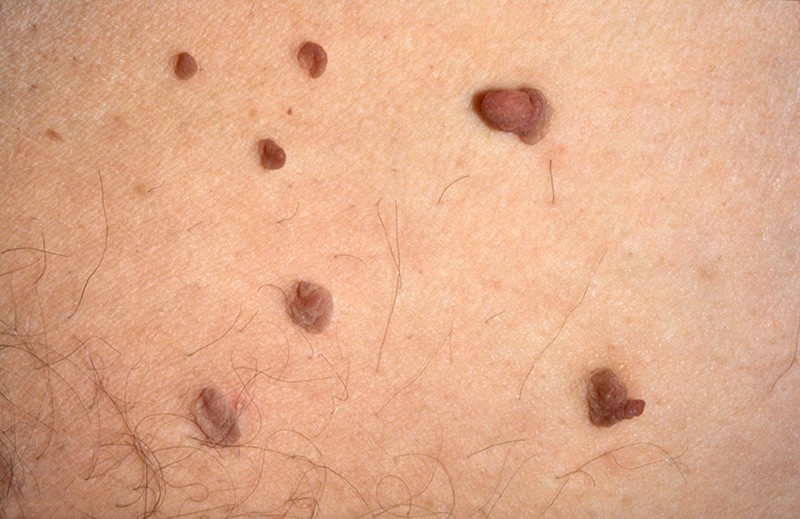Skin tags, medically known as acrochordons, are common, small, soft growths that hang off the skin. Many people develop them, especially as they get older, and while they are benign, their appearance can sometimes be a cosmetic concern or cause irritation. If you’ve noticed these fleshy little bumps and are wondering, “Why Do I Get Skin Tags?”, you’re not alone. This article will explore the reasons behind skin tag development, common symptoms, and what you can do about them.
What are Skin Tags?
Skin tags are noncancerous growths that typically appear as small, soft, skin-colored or slightly darker flaps of skin. They vary in size, from as small as a millimeter to as large as a centimeter. These tags are composed of collagen fibers and blood vessels surrounded by skin. Characteristically, skin tags are attached to the skin surface by a thin stalk called a peduncle, making them hang off the skin. They are most frequently found in areas where skin rubs against skin or clothing. Common locations include:
- Neck: Especially in skin folds.
- Armpits: Where the arm rubs against the torso.
- Groin: In the genital area and upper thigh folds.
- Under the breasts: In women, particularly under larger breasts.
- Eyelids: Small tags can appear on the delicate skin of the eyelids.
- Anus: In the anal region.
Skin tags are incredibly common, affecting almost half of all adults. While they are more prevalent with age, they can appear at any stage of adulthood. It’s important to remember that skin tags are harmless and are not a sign of a serious medical condition. However, if you find them bothersome or simply don’t like how they look, there are safe and effective removal options available.
 Image of multiple skin tags.
Image of multiple skin tags.
Symptoms of Skin Tags
For the vast majority of people, skin tags are asymptomatic. They don’t cause pain, itching, or any other discomfort. Often, people are unaware they have skin tags until they are noticed during routine activities like showering or dressing, or when they are pointed out by someone else. However, in some cases, skin tags can become symptomatic:
- Irritation: If a skin tag is located in an area where it frequently rubs against clothing, jewelry, or skin, it can become irritated. This friction can lead to redness, swelling, and discomfort.
- Bleeding: Persistent rubbing or snagging can cause a skin tag to bleed. While usually minimal, bleeding can occur if the tag is caught on something or repeatedly irritated.
- Soreness: Inflammation from irritation or minor injury can make a skin tag feel sore or tender to the touch.
It’s important to differentiate skin tags from other skin conditions. Unlike warts, which are often flat or raised with a rough surface, skin tags are soft and hang from the skin. They also differ from moles, which are typically pigmented and can be flat or raised. If you are unsure whether a skin growth is a skin tag or something else, it is always best to consult with a doctor for a proper diagnosis.
Why Do Skin Tags Develop?
While the precise cause of skin tags is not completely understood, several factors are known to contribute to their development. It’s likely a combination of genetic predisposition and lifestyle factors that lead to these common skin growths. The primary contributing factor appears to be skin friction.
Skin Friction
Skin tags are most commonly found in skin folds and areas where skin frequently rubs together. This mechanical friction is believed to play a significant role in their formation. The repeated rubbing can disrupt the normal skin structure, leading to the overgrowth of skin cells in these areas. This explains why skin tags are so common in areas like the neck, armpits, and groin.
Risk Factors Contributing to Skin Tag Development
Beyond skin friction, certain conditions and characteristics increase the likelihood of developing skin tags:
- Overweight and Obesity: People with overweight or obesity are significantly more prone to skin tags. This is likely due to increased skin folds and friction, as well as hormonal and metabolic factors associated with obesity.
- Type 2 Diabetes: Diabetes, particularly type 2, is linked to a higher prevalence of skin tags. Insulin resistance and elevated blood sugar levels may contribute to skin cell proliferation and skin tag formation.
- Age: Skin tags become more common as people age. They are relatively rare in children and adolescents but their incidence increases significantly after middle age.
- Pregnancy: Hormonal changes during pregnancy can promote skin tag development. These pregnancy-related skin tags often disappear after childbirth.
- Genetics: There is a genetic component to skin tag development. If you have family members with skin tags, you are more likely to develop them yourself.
- Skin Conditions: Conditions like Birt-Hogg-Dubé syndrome and polycystic ovary syndrome (PCOS) are also associated with an increased risk of skin tags.
It’s important to note that while these risk factors increase the likelihood of developing skin tags, anyone can get them, regardless of their health status or lifestyle. Sometimes, skin tags appear for no apparent reason.
Diagnosis of Skin Tags
Diagnosing skin tags is usually straightforward and can be done by a doctor during a simple visual examination. Typically, no special tests or procedures are needed. A doctor will examine the growth, assess its appearance and location, and ask about any symptoms or changes. Due to their characteristic appearance – a soft, pedunculated growth in typical locations – skin tags are usually easily identifiable.
In rare cases, if the appearance is atypical or there is concern about other skin conditions, the doctor may perform a skin biopsy to rule out other diagnoses. However, this is not routine for typical skin tags.
When to See a Doctor
While skin tags are harmless, there are situations when it’s advisable to see a doctor:
- New Skin Growths: Any new or changing skin growth should be evaluated by a doctor to ensure it is benign and not a sign of skin cancer or another skin condition. This is especially important if the growth is rapidly changing in size, shape, or color, or if it is painful, bleeding, or itchy.
- Bothersome Skin Tags: If a skin tag is causing persistent irritation, pain, bleeding, or is cosmetically bothersome, you should consult a doctor. They can discuss safe and effective removal options.
- Uncertainty About Diagnosis: If you are unsure whether a skin growth is a skin tag or something else, it’s always best to seek medical advice for a definitive diagnosis.
Your doctor can provide reassurance, confirm the diagnosis of skin tags, and discuss appropriate management options if desired.
Skin Tag Removal
There is generally no medical reason to remove skin tags. They pose no health risk and are not precancerous. However, many people choose to have them removed for cosmetic reasons or if they are causing discomfort. It’s strongly discouraged to attempt to remove skin tags yourself at home, as this can lead to bleeding, infection, and incomplete removal. Medical professionals can safely and effectively remove skin tags using various methods:
- Cryotherapy: This involves freezing the skin tag with liquid nitrogen. The tag will typically fall off within a week or two.
- Excision: The skin tag is surgically cut off using a scalpel or surgical scissors. This is a quick and effective method, especially for larger tags.
- Hyfrecation or Electrocautery: This method uses an electric current to burn off the skin tag.
- Ligation: For smaller tags, a surgical thread can be tied around the base to cut off blood supply, causing the tag to wither and fall off.
The best removal method depends on the size and location of the skin tag, as well as individual preferences. A doctor can advise on the most suitable option.
Can Skin Tags Be Prevented?
Unfortunately, there is no guaranteed way to prevent skin tags entirely. However, certain lifestyle measures can help reduce the risk:
- Maintain a Healthy Weight: Managing weight and preventing obesity can reduce skin folds and friction, potentially lowering the likelihood of skin tag development.
- Manage Diabetes: If you have diabetes, proper blood sugar control may help reduce the risk of skin tags.
- Reduce Skin Friction: Wearing loose-fitting clothing and using talcum powder in skin folds can help minimize skin-on-skin friction, especially in hot and humid weather.
While these measures may help, they are not foolproof, and many people will still develop skin tags due to genetic predisposition and other factors beyond their control.
In Conclusion
Skin tags are a common and benign skin condition that many people experience. While the exact reasons why individuals develop skin tags are not fully clear, skin friction, genetics, and certain health conditions like obesity and diabetes play significant roles. They are typically harmless and asymptomatic, but can be removed by a medical professional if they become bothersome. If you are concerned about skin tags or any new skin growths, consulting with a doctor is always the best course of action to receive accurate diagnosis and advice.

